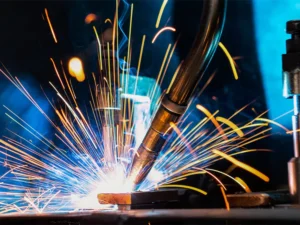Introduction:
Have you heard of deep penetration laser welding? Deep Penetration Laser Welding is an advanced welding technique. Deep Penetration Laser Welding (DPLW) utilizes a high-energy laser beam to create deep and narrow weld seams in various materials, typically metals. In this post, we will dive into how it works and its pros and cons.
The Principle of Laser Welding
Continuous or pulsed laser beams can achieve laser welding. The principle of laser welding can be divided into heat conduction welding and laser deep penetration welding.
- When the power density is less than 104~105 W/cm2, it is heat conduction welding. At this time, the penetration depth is shallow, and the welding speed is slow;
- When the power density is greater than 105~107 W/cm2, the metal surface is sunken into “cavities” by heating, forming deep penetration welding. It has the characteristics of fast welding speed and a large aspect ratio.
The principle of heat conduction laser welding is laser radiation heats the surface to be processed. And the surface heat diffuses to the inside through heat conduction. By controlling laser parameters such as laser pulse width, energy, peak power, and repetition frequency, the workpiece is melted to form a specific molten pool. The laser welding machine used for gear and metallurgical thin plate welding mainly involves deep penetration laser welding.
The following focuses on the principle of deep penetration laser welding.
The Principle of Deep Penetration Laser Welding
Laser deep penetration welding generally uses continuous laser beams to complete the connection of materials. Its metallurgical physical process is very similar to electron beam welding. The energy conversion mechanism is completed through the “key-hole” structure. Under sufficiently high power density laser irradiation, the material evaporates and forms small pores. This small hole full of steam is like a black body, absorbing almost all the energy of the incident beam. The equilibrium temperature in the cavity reaches about 2500℃. The heat is transmitted from the outer wall of the high-temperature cavity to melt the metal surrounding the cavity.
The small hole is filled with high-temperature steam generated by the continuous evaporation of the wall material under the irradiation of the beam. The walls of the small hole are surrounded by molten metal. The liquid metal is surrounded by solid materials (while in most conventional welding processes and laser conduction welding, the energy is first deposited on the workpiece’s surface and then transported to the interior by transmission).
The liquid flow outside the pore wall and the surface tension of the wall layer maintain a dynamic balance with the continuously generated vapor pressure in the pore cavity. The beam continuously enters the small hole, and the material flows from the small hole. As the beam moves, the small hole is always in a stable flow state. That is to say, the small hole and the molten metal surrounding the hole will move forward with the forward speed of the leading beam, and the molten metal fills the gap left by the small hole and condenses accordingly so that the weld is formed.
Features of Deep Penetration Laser Welding

1) High aspect ratio
As the molten metal forms around the cylindrical cavity of hot steam and extends toward the workpiece, the weld becomes deep and narrow.
2) Minimum heat input
Because the temperature in the small hole is very high, the melting process occurs extremely fast, the heat input into the workpiece is very low, and the thermal deformation and heat-affected zone are small.
3) High density
Because the small pores filled with high-temperature steam are conducive to the agitation of the weld pool and gas escape, resulting in a penetration weld without pores. The high cooling rate after welding can easily make the weld structure finer.
4) Strong welds
Because of the blazing heat source and sufficient absorption of non-metallic components, the impurity content is reduced, and the inclusions’ size and distribution in the molten pool are changed. The welding process does not require electrodes or filler wires, and the melting zone is less polluted so that the strength and toughness of the weld are at least equal to or even higher than that of the parent metal.
5) Precise control
Because the focused light spot is small, the weld seam can be positioned with high precision. The laser output has no “inertia,” it can be stopped and restarted at high speed. The complex workpiece can be welded with the numerical control beam movement technology.
6) Non-contact atmospheric welding process
The energy comes from the photon beam, there is no physical contact with the workpiece. So no external force is applied to the workpiece. In addition, magnetism and air do not affect laser light.
Advantages and Disadvantages of Deep Penetration Laser Welding
Advantages
1) The focused laser has a much higher power density than conventional methods. So the welding speed is fast, and the heat-affected zone and deformation are small. And difficult-to-weld materials such as titanium can also be welded.
2) The light beam is easy to transmit and control, there is no need to replace the torch and nozzle frequently. There is no vacuum required for electron beam welding. This significantly reduces the auxiliary downtime time. So the load factor and production efficiency are high.
3) The weld strength, toughness, and comprehensive performance are high due to the purification effect and high cooling rate.
4) Due to the low average heat input and high machining accuracy, the cost of reprocessing can be reduced; in addition, the operating cost of laser welding is also low, which can reduce the cost of workpiece processing.
5) It can effectively control the beam intensity and fine positioning, making it easy to realize automatic operation.
Disadvantages
1) Welding depth is limited.
2) The assembly requirements of the workpiece are high.
3) The one-time investment in the laser system is relatively high.

